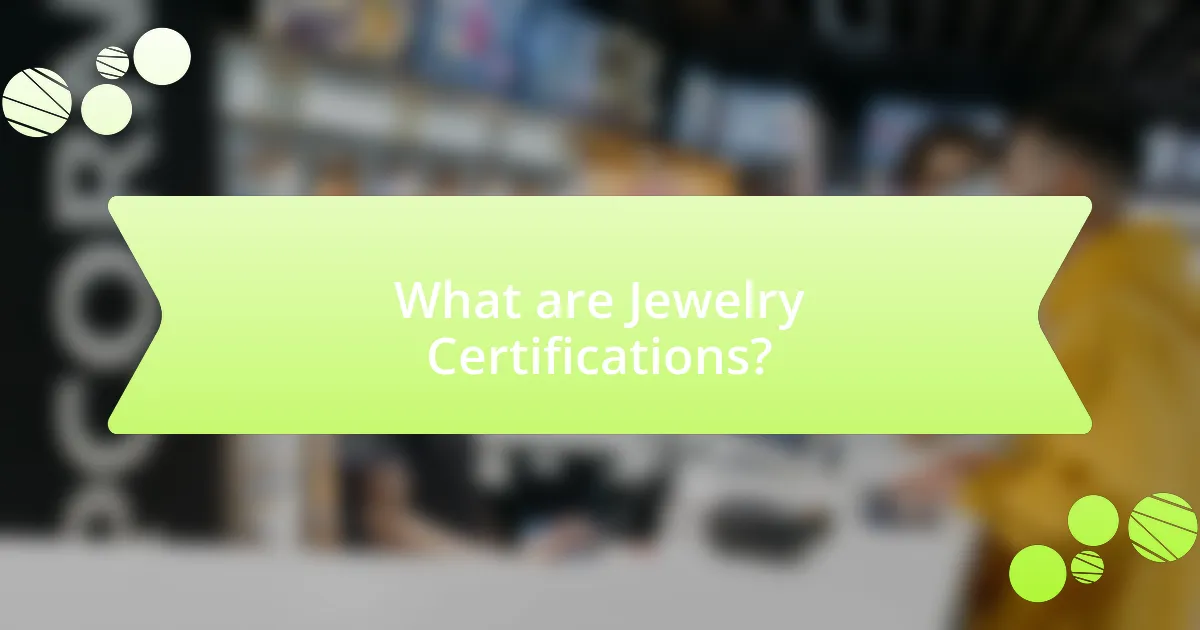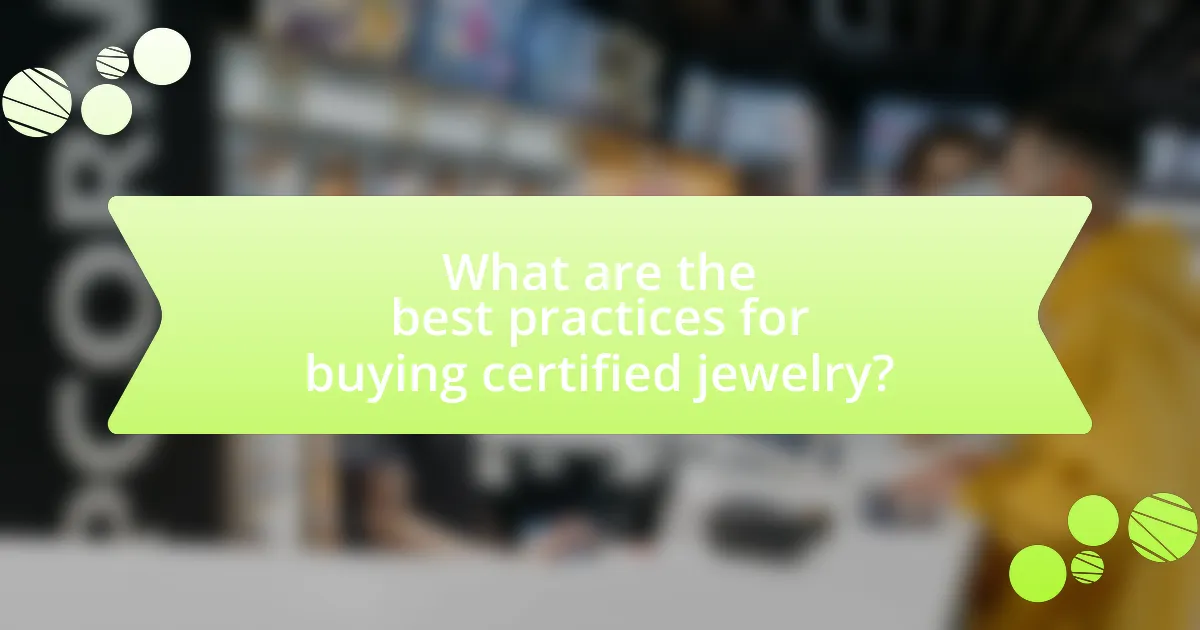Jewelry certifications are official documents that verify the quality, authenticity, and characteristics of gemstones and precious metals used in jewelry. This article provides a comprehensive overview of the importance of jewelry certifications for buyers, detailing how they enhance consumer trust, impact jewelry value, and differentiate between various certification types. It also addresses common misconceptions, outlines best practices for purchasing certified jewelry, and offers guidance on verifying certifications and understanding grading standards. By educating themselves on these aspects, buyers can make informed decisions and ensure the authenticity and quality of their jewelry purchases.

What are Jewelry Certifications?
Jewelry certifications are official documents that verify the quality, authenticity, and characteristics of gemstones and precious metals used in jewelry. These certifications are typically issued by reputable gemological laboratories and provide detailed information about the jewelry, including the type of gemstone, its cut, clarity, color, carat weight, and any treatments it may have undergone. For example, the Gemological Institute of America (GIA) is a well-known organization that provides such certifications, ensuring that consumers receive accurate and reliable information about their jewelry purchases.
Why are Jewelry Certifications important for buyers?
Jewelry certifications are important for buyers because they provide verified information about the quality and authenticity of the jewelry. These certifications, issued by reputable gemological laboratories, confirm the characteristics of gemstones, such as their cut, color, clarity, and carat weight, ensuring that buyers receive exactly what they are paying for. For instance, a certification from the Gemological Institute of America (GIA) is widely recognized and assures buyers that the gemstone has been evaluated by experts using standardized criteria. This not only helps in making informed purchasing decisions but also protects buyers from fraud and misrepresentation in the jewelry market.
How do certifications impact the value of jewelry?
Certifications significantly enhance the value of jewelry by providing verified proof of quality, authenticity, and craftsmanship. Jewelry that comes with certifications from reputable organizations, such as the Gemological Institute of America (GIA) or the American Gem Society (AGS), assures buyers of the gem’s characteristics, including cut, color, clarity, and carat weight. For instance, a diamond graded by the GIA can command a higher price due to the institute’s rigorous standards and global recognition. This verification reduces the risk of fraud and increases buyer confidence, ultimately leading to higher resale values.
What role do certifications play in consumer trust?
Certifications play a crucial role in enhancing consumer trust by providing verified assurance of product quality and authenticity. When consumers see certifications, such as those from reputable organizations, they gain confidence that the jewelry meets specific standards for quality, ethical sourcing, and craftsmanship. For instance, the Gemological Institute of America (GIA) certification is widely recognized and indicates that a gemstone has been evaluated by experts, ensuring its quality and characteristics are accurately represented. This transparency reduces the perceived risk associated with purchasing jewelry, leading to increased consumer satisfaction and loyalty.
What types of Jewelry Certifications exist?
Various types of jewelry certifications exist, including those for gemstones, diamonds, and precious metals. Gemstone certifications, such as those from the Gemological Institute of America (GIA) or the International Gemological Institute (IGI), provide detailed reports on the quality and authenticity of gemstones. Diamond certifications, primarily from GIA and the American Gem Society (AGS), assess the cut, clarity, color, and carat weight of diamonds. Precious metal certifications, like those from the Assay Office, verify the purity and authenticity of gold, silver, and platinum. These certifications are crucial for ensuring the quality and value of jewelry, as they provide buyers with verified information about their purchases.
What is the difference between gemological and appraisal certifications?
Gemological certifications focus on the identification and grading of gemstones, assessing their quality based on specific criteria such as cut, color, clarity, and carat weight. In contrast, appraisal certifications provide a monetary value for the gemstone or jewelry piece, often considering market trends, condition, and comparable sales. Gemological certifications are typically issued by recognized gemological laboratories, while appraisal certifications are provided by qualified appraisers who may or may not have gemological training. This distinction is crucial for buyers, as gemological certifications ensure the authenticity and quality of the gemstone, whereas appraisal certifications determine its financial worth.
How do different certification bodies vary in their standards?
Different certification bodies vary in their standards primarily through the criteria they use to evaluate gemstones and jewelry. For instance, the Gemological Institute of America (GIA) employs a rigorous grading system based on the Four Cs: cut, color, clarity, and carat weight, which is widely recognized and respected in the industry. In contrast, the International Gemological Institute (IGI) may have slightly different grading criteria and may prioritize certain aspects over others, leading to variations in the final grades assigned to the same gemstone. Additionally, some certification bodies may focus on specific types of gemstones or have unique methodologies for assessing quality, which can further differentiate their standards. These differences can impact the perceived value and marketability of certified jewelry, as consumers often rely on the reputation and grading consistency of the certification body.
How can buyers verify Jewelry Certifications?
Buyers can verify jewelry certifications by checking the authenticity of the certification document against the issuing authority’s database. Reputable gemological laboratories, such as the Gemological Institute of America (GIA) or the American Gem Society (AGS), provide online tools where buyers can enter the certification number to confirm its validity. This process ensures that the certification is genuine and corresponds to the specific piece of jewelry being purchased. Additionally, buyers should look for certifications that include detailed information about the gemstone’s characteristics, such as cut, color, clarity, and carat weight, as these details further validate the certification’s credibility.
What steps should buyers take to authenticate a certification?
Buyers should take the following steps to authenticate a certification: first, verify the issuing authority of the certification by checking if it is recognized and reputable within the jewelry industry. Next, examine the certification details, ensuring they match the specific item being purchased, including the gem’s characteristics such as carat weight, color, clarity, and cut. Additionally, buyers should cross-reference the certification with online databases or resources provided by the certifying organization to confirm its validity. Finally, consult with a qualified gemologist or jewelry expert for an independent assessment of the certification and the item itself. These steps ensure that buyers are making informed decisions based on credible and accurate information.
How can buyers identify reputable certification organizations?
Buyers can identify reputable certification organizations by verifying their accreditation and recognition within the industry. Reputable organizations are often accredited by recognized authorities, such as the International Organization for Standardization (ISO) or national standards bodies, which ensures they adhere to established guidelines and practices. Additionally, buyers should look for organizations that have a transparent certification process, provide detailed reports, and are well-regarded by industry professionals and jewelers. For example, organizations like the Gemological Institute of America (GIA) and the American Gem Society (AGS) are widely recognized for their rigorous standards and credibility in the jewelry certification field.

What should buyers consider when choosing certified jewelry?
Buyers should consider the certification type, which indicates the quality and authenticity of the jewelry. Certifications from reputable organizations, such as the Gemological Institute of America (GIA) or the American Gem Society (AGS), provide detailed assessments of gemstones, including their cut, color, clarity, and carat weight. Additionally, buyers should verify the credibility of the certifying body, as recognized institutions adhere to strict grading standards, ensuring the jewelry’s value and quality. Understanding the specific grading criteria used by these organizations can also help buyers make informed decisions, as it directly impacts the jewelry’s market value and resale potential.
How does the certification affect the purchasing decision?
Certification significantly influences purchasing decisions by providing assurance of quality and authenticity. Buyers often rely on certifications to validate the value of jewelry, as these documents confirm that the piece meets specific standards set by recognized authorities. For instance, a diamond certified by the Gemological Institute of America (GIA) is perceived as more trustworthy, leading to a higher likelihood of purchase. Studies indicate that 70% of consumers consider certification essential when buying gemstones, highlighting its critical role in establishing buyer confidence and justifying price points.
What factors should be prioritized when evaluating certified jewelry?
When evaluating certified jewelry, the most important factors to prioritize are the certification authority, the quality of the materials, and the craftsmanship. The certification authority, such as the Gemological Institute of America (GIA) or the American Gem Society (AGS), provides credibility and assurance regarding the authenticity and quality of the jewelry. The quality of materials, including the type of gemstones and metals used, directly impacts the value and durability of the piece. Lastly, craftsmanship refers to the skill and precision involved in creating the jewelry, which affects both aesthetic appeal and longevity. These factors collectively ensure that the jewelry is not only genuine but also a worthwhile investment.
How can buyers assess the credibility of the certification?
Buyers can assess the credibility of a certification by verifying the issuing organization’s reputation and standards. Reputable certifying bodies, such as the Gemological Institute of America (GIA) or the American Gem Society (AGS), adhere to strict guidelines and are recognized within the industry. Buyers should also check if the certification includes detailed information about the item, such as its quality, characteristics, and any grading scales used. Additionally, cross-referencing the certification with the certifying body’s database can confirm its authenticity. This process ensures that the certification is legitimate and reflects the true value of the jewelry.
What are common misconceptions about Jewelry Certifications?
Common misconceptions about jewelry certifications include the belief that all certifications are equal and that they guarantee the quality of the jewelry. In reality, different certification organizations have varying standards and methodologies, which can lead to significant differences in the reliability of the certification. For example, the Gemological Institute of America (GIA) is widely recognized for its rigorous grading standards, while other organizations may not adhere to the same level of scrutiny. Additionally, some buyers mistakenly think that a certification automatically increases the value of the jewelry, but value is also influenced by market demand, brand reputation, and other factors beyond certification alone.
Why do some buyers overlook the importance of certifications?
Some buyers overlook the importance of certifications because they prioritize price and aesthetic appeal over quality assurance. Many consumers may lack awareness of how certifications validate the authenticity and quality of jewelry, leading them to make uninformed purchasing decisions. Research indicates that approximately 60% of jewelry buyers do not consider certifications essential, often due to misconceptions about their relevance or a belief that they can assess quality through visual inspection alone. This lack of understanding can result in buyers missing out on crucial information that certifications provide, such as gemstone origin and grading standards.
What myths exist regarding the reliability of certifications?
Myths regarding the reliability of certifications include the belief that all certifications guarantee quality and authenticity, and that certifications are universally recognized across all markets. In reality, not all certifications are created equal; some may be issued by organizations with varying levels of credibility and expertise. For instance, the Gemological Institute of America (GIA) is widely respected, while other lesser-known entities may not adhere to the same rigorous standards. Additionally, the recognition of certifications can differ by region, meaning a certification accepted in one country may not hold the same weight in another. This discrepancy can lead to misunderstandings about the value and reliability of a certification when purchasing jewelry.

What are the best practices for buying certified jewelry?
The best practices for buying certified jewelry include verifying the certification from a reputable gemological laboratory, understanding the specific grading criteria used, and ensuring that the jewelry comes with a detailed report. Reputable laboratories, such as the Gemological Institute of America (GIA) or the American Gem Society (AGS), provide reliable certifications that detail the quality and authenticity of the gemstones. Familiarizing oneself with the grading scales for cut, color, clarity, and carat weight is essential, as these factors significantly influence the value of the jewelry. Additionally, requesting a return policy and ensuring the jewelry is accompanied by a warranty can protect the buyer’s investment.
How can buyers ensure they are making informed decisions?
Buyers can ensure they are making informed decisions by thoroughly researching jewelry certifications and understanding their significance. Familiarizing themselves with reputable certification organizations, such as the Gemological Institute of America (GIA) and the American Gem Society (AGS), allows buyers to verify the quality and authenticity of gemstones and jewelry. According to a 2021 survey by the Jewelers of America, 85% of consumers reported that they felt more confident in their purchases when the jewelry was accompanied by a recognized certification. This highlights the importance of certifications in providing assurance regarding the value and quality of jewelry.
What questions should buyers ask when presented with a certification?
Buyers should ask the following questions when presented with a certification: “What does the certification guarantee?” This question helps clarify the specific attributes of the jewelry being certified, such as quality, authenticity, and origin. Additionally, buyers should inquire, “Who issued the certification?” Knowing the issuing authority is crucial, as reputable organizations like the Gemological Institute of America (GIA) or the American Gem Society (AGS) provide more reliable certifications. Another important question is, “What criteria were used for the certification?” Understanding the standards and methods used in the evaluation process ensures that buyers are aware of how the certification was determined. Lastly, buyers should ask, “Is the certification up-to-date?” Certifications can change over time, and confirming the current status is essential for making informed purchasing decisions.
How can buyers compare certifications across different pieces of jewelry?
Buyers can compare certifications across different pieces of jewelry by examining the grading standards and issuing organizations of each certification. For instance, certifications from reputable gemological laboratories like the Gemological Institute of America (GIA) or the American Gem Society (AGS) provide detailed reports on the quality of gemstones, including cut, color, clarity, and carat weight. Buyers should look for consistency in these grading criteria, as different labs may have varying standards. Additionally, buyers can assess the transparency of the certification process and the reputation of the issuing organization, as established labs typically adhere to strict guidelines and provide reliable evaluations. This approach ensures that buyers make informed decisions based on credible and comparable information.
What tips can help buyers navigate the certification process?
Buyers can navigate the certification process by thoroughly researching the specific certifications relevant to their jewelry purchase. Understanding the differences between certifications, such as those from the Gemological Institute of America (GIA) or the American Gem Society (AGS), is crucial, as each organization has its own grading standards and methodologies. Additionally, buyers should verify the authenticity of the certification by checking the issuing organization’s website or contacting them directly, ensuring that the certificate matches the jewelry in question. This diligence helps buyers make informed decisions and avoid potential fraud, as a 2021 report by the Jewelers of America indicated that approximately 30% of consumers encountered misleading information regarding jewelry certifications.
How can buyers educate themselves about jewelry certifications?
Buyers can educate themselves about jewelry certifications by researching reputable certification organizations such as the Gemological Institute of America (GIA) and the American Gem Society (AGS). These organizations provide detailed information on the grading and evaluation processes for diamonds and gemstones, which helps buyers understand the significance of certifications. Additionally, buyers can access online resources, attend workshops, and read books focused on gemology to gain a deeper understanding of the criteria used in jewelry certifications. This knowledge empowers buyers to make informed purchasing decisions and recognize the value of certified jewelry.
What resources are available for understanding jewelry certifications better?
To understand jewelry certifications better, several resources are available, including educational websites, industry publications, and certification bodies. Websites like the Gemological Institute of America (GIA) provide comprehensive information on various certifications, grading standards, and educational materials. Industry publications such as “JCK Magazine” and “National Jeweler” offer insights into trends and updates in jewelry certifications. Additionally, organizations like the American Gem Society (AGS) and the International Gemological Institute (IGI) publish guidelines and resources that explain their certification processes and standards, helping consumers make informed decisions.